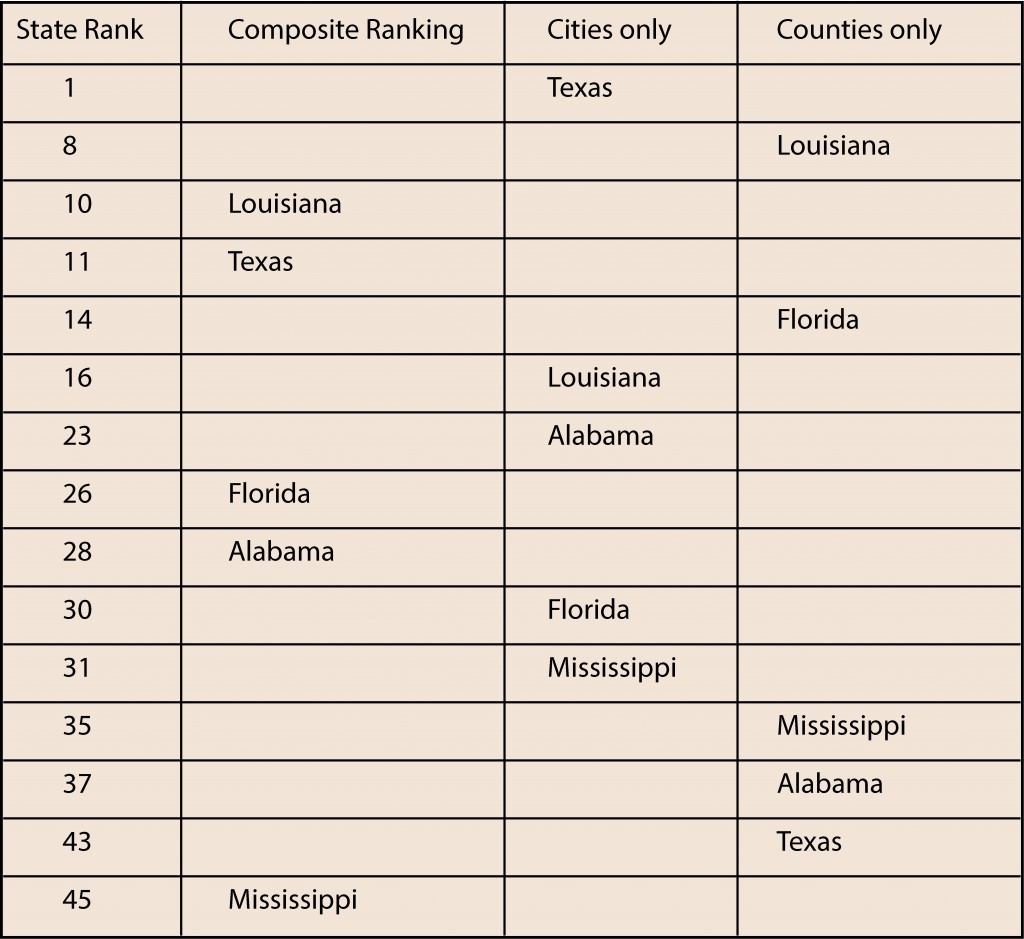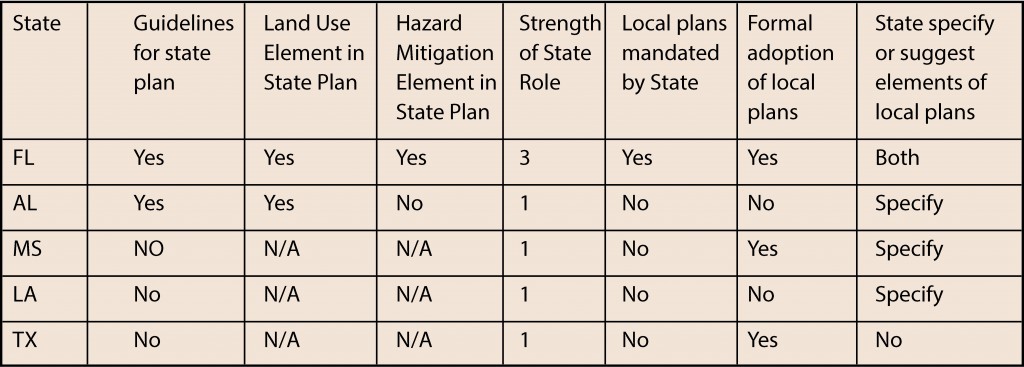Florida as an Example of Strong State Leadership
Comparison of other Gulf State Plans
Five Powers of local government to plan and implement hazard mitigation
Drainage and Flood Control Districts
State government plays a role in local planning through its ability to require plans at either the state or local level
As might be expected, there is considerable variation among the Gulf Coast states in terms of practice and/or requirements (Table 1 below). Most Gulf communities do have zoning plans and ordinances to regulate development, but Florida is the only Gulf state to mandate local plans and the only state to include hazard mitigation within the state plan, and is thus the Gulf state with the strongest overall role by far in terms of planning. All the states have the constitutional ability to plan, but only three of the five states have some kind of state plan in place (Table 1).
Traditionally, the highest degree of independence of a local government is “home rule,” which essentially means that a local government may exercise all governmental powers, except those expressly limited by the state. In Alabama, where neither county nor municipal governments have home rule, for example, local governments have fairly low autonomy, although both counties and cities can engage in some form of planning.
But home rule is apparently not the only parameter that determines the degree of autonomy. A 1980 survey of local discretionary authority rated Alabama significantly higher than Mississippi, where both cities and counties have at least nominal home rule (Table 1).
Texas is a very interesting case. Its municipalities are ranked the highest in the country in terms of discretionary authority. Municipalities have all power except that which has been limited by the state legislature. It is, of course, one thing to have power and quite another to have the political will to execute it. Texas counties, on the other hand, are ranked 43rd nationally in terms of planning power. Texas counties have only that power specifically granted to them by the legislature.
Florida as an example of strong state leadership
Planning authority and home rule alone, however, are not enough to insure that good plans, particularly land use plans, are in place. Louisiana parishes and municipalities have all the planning power they need (the highest composite ranking for local government in Table 3), but as Katrina laid bare, virtually none had developed any viable land use plans incorporating coastal hazard planning.
The Florida example demonstrates that strong state leadership is needed to ensure that counties and cities develop effective plans, but that these are best implemented when local governments have the maximum degree of autonomy. In terms of composite ranking for local autonomy, Florida ranked in the middle of the five Gulf states (Table 1), well below Louisiana and Texas, but neither of these states have strong state mandates for land use plans incorporating hazard mitigation.
In Florida, both counties and cities have home rule and the authority to plan, even though the state exercises a very strong presence in terms of planning. Evidence from Florida and other states suggest that it may be the combination of strong state authority combined with strong local autonomy that produces the best results in terms of effective local land use plans.
For example, Florida’s Growth Management Act requires counties and municipalities to develop Local Government Comprehensive Plans that guide future growth and development. Each plan must contain a number of required “elements” that address such things as future land use, coastal management, and conservation. The Florida Department of Community Affairs reviews the plans and provides technical training and financial assistance to help local governments comply with the Act. Coastal counties must include specific “coastal management elements” in their comprehensive plans, and these should attempt to limit densities in higher hazard areas.
Florida also requires its coastal counties to have Comprehensive Emergency Management Plans and Local Mitigation Strategy plans. Most significantly, there is a requirement for counties to at least have a “statement of intent” to develop a Post Disaster Redevelopment Plan (PDRP). The PDRP is significant because the time to plan for recovery and redevelopment is before the storm, not after when strategic planning will be very difficult.
Florida classifies hazard areas along the coast in terms of their vulnerability, and comprehensive plans must address development in each of these areas. The Coastal High Hazard Zone includes areas to be evacuated in Category 1 and higher storms, the Hurricane Vulnerability Zone is roughly defined by Category 3 evacuation zones, and the Coastal Planning Area, is a somewhat broader area often associated with the entire jurisdictions of coastal counties.
Florida’s Department of Community Affairs (2005) has recently developed an extensive guidebook describing how the Florida system works. The Protecting Florida’s Communities guidebook also contains a wealth of specific information on best management planning practices that should be studied by any community interesting in minimizing vulnerability to flooding and coastal storms.
Comparison of other Gulf State Plans
There is a very wide divergence relative to planning powers and authority between Florida and the rest of the Gulf Coast states, at both the state and municipal levels (see Tables 2 and 3 below). Florida has a much stronger planning environment than any of the other states on the Gulf, and apparently it makes a very big difference, as evidenced in disaster relief payments as evidenced by studies that show one coastal insurance claim per thousand residents from 1978 to 2002 for Florida, versus twenty-one per thousand in Texas during the same period, with per capita insurance payments of $71 for Florida versus $325 in Texas.
While land use planning is very much a local government issue, how much authority local governments have to plan is dependent on what has been granted to them by the state (Table 3).
While most of the Gulf states aside from Florida have no real land use planning provisions or mandates, all of the states do exercise some control over building in the near-shore area. All of the Gulf states exert jurisdiction over submerged lands and require permits for bulkheads or structures that are built in or impinge on these lands. Coastal sand dunes are protected to one degree or another by states and/or local governments across the Gulf.
The Texas Open Beaches Act is perhaps the strongest of all state controls in the nation in terms of building on or near the ocean-side Gulf shores. Texas maintains a rolling easement that shifts with the vegetation line on barrier island Gulf-side shores. Houses found on the seaward side of this line after a major storm must be moved.
Five Powers of local government to plan and implement hazard mitigation
There are five specific powers of local government in terms of the ability to plan and implement hazard mitigation —planning, regulatory, spending, taxing, and acquisition. Full use of these powers could theoretically only occur under home rule conditions. The ability to develop, implement and enforce effective hazard mitigation plans obviously depends greatly, then, on whether or not a local unit of government has home rule powers.
For the purposes of hazard mitigation and planning, policymakers need to be aware of the limitations of local government authority in their states and take steps to fill any gaps that may exist. One option is a Home-Rule Amendment. According to a leading legal treatise, “under home-rule amendments, cities no longer are depending upon the state legislature for their authority to determine their local affairs and government, but have power granted directly from the people through the state constitution without statutory authorization.” Such amendments can significantly increase the ability of local governments to deal with changing circumstances and new threats.
Divergence in the authority to plan amongst local levels of government can have some real consequences in terms of how well plans might actually be carried out.
In Texas, for example, municipalities have considerable planning and enforcement powers, but counties in Texas have virtually no planning power outside of a few critical health and safety issues. The existence of strict city plans may result in development moving into the less restrictive “unincorporated” areas of the county, thus circumventing city planning. Some Texas counties, particularly in urban areas, have been petitioning the state legislature for years for more home rule powers. The city and county divergence is evident in Table 1 above, where Texas was ranked highest in the nation in terms of autonomy of municipalities, but near the bottom in terms of counties.
Drainage and Flood Control Districts
 Drainage and/or flood control districts also play a very important local role in floodplain and drainage management, and could have an important role to play in adapting to the impacts of climate change and population growth. Drainage districts are usually formed on a county level, but frequently are constituted on a sub-county level. Where they occur, they are often also the floodplain administrator. Drainage districts are formed where low-lying terrain results in poor drainage, such that ditches and other drainage or flood control works must be constructed to enable agriculture as well as the establishment of cities and towns.
Drainage and/or flood control districts also play a very important local role in floodplain and drainage management, and could have an important role to play in adapting to the impacts of climate change and population growth. Drainage districts are usually formed on a county level, but frequently are constituted on a sub-county level. Where they occur, they are often also the floodplain administrator. Drainage districts are formed where low-lying terrain results in poor drainage, such that ditches and other drainage or flood control works must be constructed to enable agriculture as well as the establishment of cities and towns.
Virtually all of the coastal counties along the U.S. Gulf Coast have drainage districts. Smaller districts, particularly sub-county districts, primarily construct relatively small drainage ditches, while larger districts, such as the Harris County Flood Control District (Houston), are involved in major public works projects including channelization of large streams, and the construction of large detention and retention basins. The bigger districts frequently partner with the U.S. Army Corps of Engineers on larger projects.
Florida is again unique in that drainage and other water functions are coordinated on a regional basis. Florida has five regional water management districts that regulate and manage irrigation, wetland permits, and water supply, as well as drainage and flood control. This regionalization provides Floridians with a much greater degree of adaptability and flexibility for dealing with current and future problems associated with the climate not available to the other Gulf states.



![Extracted from American Planning Association 1996 Summary of State Planning Statues [http://www.planning.org/growingsmart/summaries.html]) and internet sources](https://tcwp.tamu.edu/wp-content/uploads/sites/4/2013/03/table2-1024x389.jpg)


